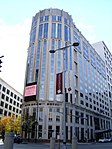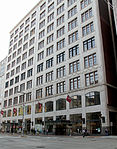Sterling-Lindner Co.

Sterling Lindner Davis (SLD) was a major department store in downtown Cleveland's Theater District which operated from 1845 (with the founding of Sterling & Welch) to 1968. The retailer was primarily known for displaying the largest decorated Christmas tree in the state of Ohio, this tradition started in 1927. At their peak, Cleveland's department stores (May, Higbee's, Bailey's, Taylor's, Halle, and SLD or the big six) were one of the largest shopping districts in the United States. Before the explosive growth of Cleveland's suburban post World War II housing boom, people would flock to downtown's Euclid Avenue dressed in the finery of their Sunday best to shop in these huge stores that carried everything from clothing and jewelry to furniture and housewares. Though the idea of the largest tree in Cleveland is an attributed to Higbee's in A Christmas Story in 1983, the tradition was actually that of SLD, not Higbee's, which were in fact (along with May and Halle) huge rivals and constantly attempting to outdo each other in ever growing extravagance of merchandise and audacity of style. Sterling Lindner Davis was a conglomeration of three previously separate companies: Sterling & Welch, Lindner Co., and W. B. DavisCo. Lindner & Davis was bought by Allied Stores in 1947, which then bought out Sterling & Welch, and the store became known as Sterling Lindner Davis in 1951. The store closed to little notice (due to the birth of malls and outlets) in 1968. By the end of the 1990s, none of the "big six" Cleveland department stores was still in operation.
Excerpt from the Wikipedia article Sterling-Lindner Co. (License: CC BY-SA 3.0, Authors, Images).Sterling-Lindner Co.
Euclid Avenue, Cleveland
Geographical coordinates (GPS) Address Nearby Places Show on map
Geographical coordinates (GPS)
| Latitude | Longitude |
|---|---|
| N 41.501194444444 ° | E -81.683527777778 ° |
Address
The Sterling Building
Euclid Avenue 1255
44115 Cleveland
Ohio, United States
Open on Google Maps









